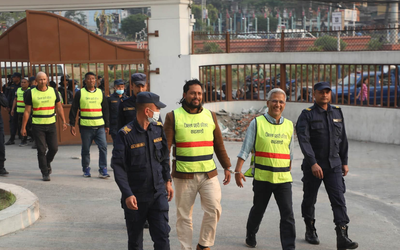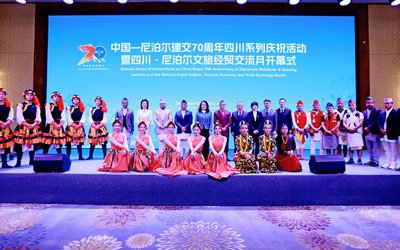More on News





Declaring that ‘Every Child Counts', UNICEF yesterday urged greater effort and innovation to identify and address the gaps that prevent the most disadvantaged of the world's 2.2 billion children from enjoying their rights.
The children's agency, in a report released on 30th January in New York, highlights the importance of data in making progress for children and exposing the unequal access to services and protections that mars the lives of so many.
“Data have made it possible to save and improve the lives of millions of children, especially the most deprived,” said Tessa Wardlaw, Chief of UNICEF’s Data and Analytics Section. “Further progress can only be made if we know which children are the most neglected, where girls and boys are out of school, where disease is rampant or where basic sanitation is lacking.”
Tremendous progress has been made since the Convention on the Rights of the Child (CRC) was signed in 1989 and in the run up to the culmination of the Millennium Development Goals in 2015. UNICEF's flagship report, The State of the World's Children 2014 in Numbers shows that:
Some 90 million children who would have died before reaching the age of 5 if child mortality rates had stuck at their 1990 level have, instead, lived. In large measure, this is because of progress in delivering immunizations, health, and water and sanitation services.
In Nepal too there have been tremendous gains in the under-5 mortality rates. The annual rate of reduction for the under-5 mortality rate from 1990 to 2012 is 5.6 per cent. While the probability of children dying between birth and five years was 269 per 1000 live births in 1970, the rate dropped to 142 in 1990, 82 in 2000 and slid down further to 42 in 2012. It is interesting to note that this under 5 mortality rate of 42 is well below Nepal's MDG 4 target of 54. Disaggregated by sex, there were more male children, 44, not reaching their 5th birthday than female children -39. There are now more babies surviving beyond the age of 1 these days-for while in 1990 there were 99 babies (out of 1000) who failed to survive, the rate has plummeted to 34 in 2012.
Nepal ranks 59th (out of 194 countries, in descending order) in terms of under-five mortality ranking, a critical indicator of the well-being of children. The ranking of other countries in the region are Afghanistan 18th, Pakistan 26th, India 49th, Bhutan 57th Bangladesh 60th, Maldives 132nd, and Sri Lanka faring best at 136th position.
Globally improvements in nutrition have led to a 37 per cent drop in stunting since 1990.
According to the Report, data from 2008 to 2012 for Nepal indicates that out of every 100 girls and boys, 29 are moderately or severely underweight, 41 are moderately to severely stunted and 11 suffer from moderate or severe wasting.
Despite the progress, the statistics in the report, titled "Every Child Counts: Revealing disparities, advancing children's rights," also bear witness to ongoing violations of children's rights:
Fifteen per cent of the world’s children are put to work that compromises their right to protection from economic exploitation and infringes on their right to learn and play.
Globally, eleven per cent of girls are married before they turn 15, jeopardizing their rights to health, education and protection while in Nepal (2005-2012) data shows that child marriage is still a major challenge. While one in every 10 women aged between 20-24 said they were married by the age of 15, 41% said they were married before they were 18-years old.
Data also reveal gaps and inequities, showing the gains of development are unevenly distributed:
The world’s poorest children are nearly three (2.7) times less likely than the richest ones to have a skilled attendant at their birth, leaving them and their mothers at increased risk of birth-related complications.
In Nepal only 32 out of every 100 women in rural areas had a skilled attendant (doctors, nurses or midwifes) at birth compared to 73 in urban areas. Similarly, 82% of women in the upper wealth quintile were more likely to have skilled attendant during delivery compared to 11% of women in the lowest wealth quintile.
The report notes that "being counted makes children visible, and this act of recognition makes it possible to address their needs and advance their rights." It adds that innovations in data collection, analysis and dissemination are making it possible to disaggregate data by such factors as location, wealth, sex, and ethnic or disability status, to include children who have been excluded or overlooked by broad averages.
The report urges increased investment in innovations that right the wrong of exclusion.
"Overcoming exclusion begins with inclusive data. To improve the reach, availability and reliability of data on the deprivations with which children and their families contend, the tools of collection and analysis are constantly being modified – and new ones are being developed. This will require sustained investment and commitment," the report says.
Much of what is known about the situations of children comes from household surveys, and in particular the Multiple Indicator Cluster Surveys (MICS). Designed and supported by UNICEF, MICS are conducted by national statistical authorities and provide disaggregated data on a range of topics affecting children's survival, development, rights and experience of life. To date, MICS surveys have been conducted in more than 100 countries. In the last round of MICS, interviews were completed in more than 650,000 households in 50 countries, including in Nepal. Nepal conducted the first round of MICs in 2010 covering 24 districts of the Mid and far West of Nepal. Round Five of MICS is being implemented in Nepal in 2014. This will provide data for final MDG reporting, Monitoring Results for Equity Systems (MoRES), as well as for monitoring commitments made toward "A Promise Renewed."
Thirty years have passed since The State of the World’s Children began to publish tables of standardized global and national statistics aimed at providing a detailed picture of children’s circumstances. With the release of an edition of the report dedicated to data, UNICEF is inviting decision-makers and the general public to access and use its statistics - at www.data.unicef.org - to drive positive change for children.
"Data do not, of themselves, change the world. They make change possible – by identifying needs, supporting advocacy, and gauging progress. What matters most is that decision-makers use the data to make positive change, and that the data are available for children and communities to use in holding duty-bearers to account,” the report said.






